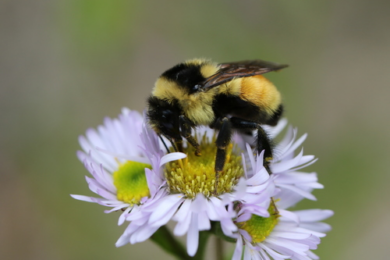
Tricolored Bumble Bee on an Aster plant Photo by Spencer Hardy
Pollinators, such as bees, flies, butterflies, and moths, play a vital role in maintaining biodiversity and ecosystem health by helping flowering plants reproduce. Unfortunately, pollinator populations are declining globally due to many factors, including habitat loss, disease, pesticide use, and climate change. Planting native species is one way to support pollinator habitat, as native plants have coevolved alongside native pollinators and provide essential habitat and food resources.
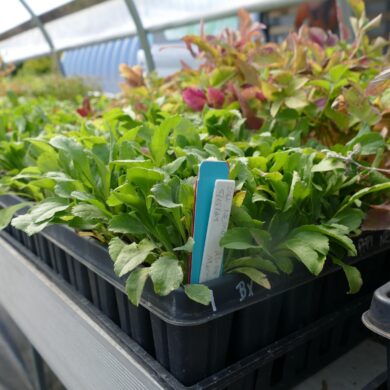
Seedling of Gray Goldenrod (Solidago nemoralis) Photo by Desiree Narango
In recent years, the demand for native plants has grown exponentially. However, the available provenance (i.e., the geographic source) typically comes from non-local sources because of local seed stock and supply chain limitations.
Why does this matter? Many native plants have broad distributions that cover multiple ecoregions in the US, and these specific plant populations (also called ‘ecotypes’ are often adapted to the areas they are from, potentially affecting plant traits like flowering time and abundance. Pollinators are often assumed to prefer local ecotypes, but there has been limited scientific evidence to test this explicitly.
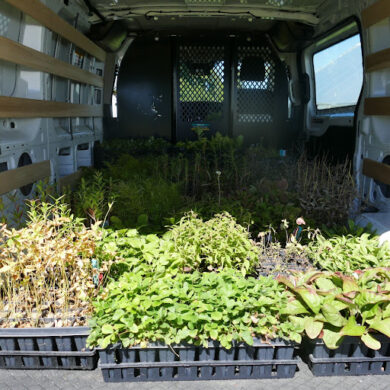
Van loaded with plant starts from Nasami Farms, Native Plant Trust: Photo by Desiree Narango
To better understand how pollinators interact with plants from different provenances, VCE Conservation Biologists Desiree Narango and Ryan Rebozo have launched a new three-year project with the Native Plant Trust (NPT) with funding from the One Hive Foundation.
Our new study involves establishing six experimental common gardens across the Upper Valley of Vermont and New Hampshire, encompassing a range of habitats and prior land use. During the winter, we grew twelve perennial plants sourced from three different ecoregions (Northeast, Southeast, and Midwest) at the Native Plant Trust’s Nasami Farm Nursery in Western Massachusetts.
In September 2024, the plant provenance research team, with the help of many volunteers, planted the gardens in Quechee, East Thetford, Woodstock, Lyme, Hartford, and Hartland. Each garden is divided into thirty-six plots, and each plot contains five plants of a particular species and provenance in a randomized block design. Many thanks to the fantastic volunteers who came out to help us with our gardens!
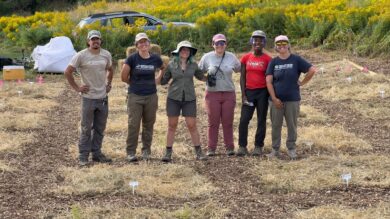
Planting day with VCE staff at Billings Farm and Museum in Woodstock, VT Photo by Kent McFarland
Starting in the spring of 2025, the team will monitor plant growth, timing, flower resources, and insect activity by conducting regular surveys in each garden. Some of our data will involve counting the number of flowers and seeds produced and comparing the quality of the pollen and nectar by testing nutrient content. In addition to plant surveys, the research group will assess how well local and non-local provenances support insects. This will involve observing and identifying which flowers pollinators are visiting and assessing diversity, abundance, and behavior. We are particularly interested in using bumble bees as a model pollinator to assess flower fidelity because bumble bees are known to exhibit discrimination among flowers based on fine-scale differences in color, shape, and pollen nutrients.
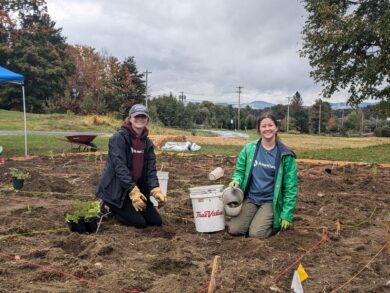
Planting day with ECO AmeriCorps volunteers at Sunrise Farm in Hartford, VT Photo by Onome Ofoman
In addition to the community gardens, we are also developing a new community science project where participants ‘adopt’ plants of different provenances for their home gardens and perform periodic five-minute focal watches to record plant and pollinator observations. Please fill out this form to get more information and indicate your interest. We’ll contact interested participants in spring 2025 with more details about plant pick-up opportunities and protocols.
The results of this study will provide valuable insights into whether plant provenance affects a plant’s ability to support pollinators. This information will be critical for conserving and managing native plant populations that also support pollinators. Additionally, the research findings can inform restoration and landscaping practices to create environments that benefit people and biodiversity.
